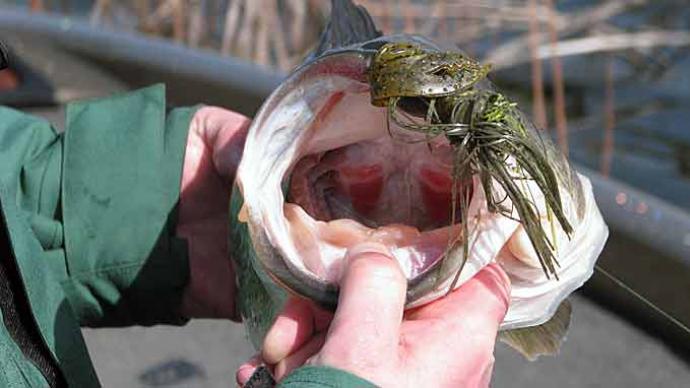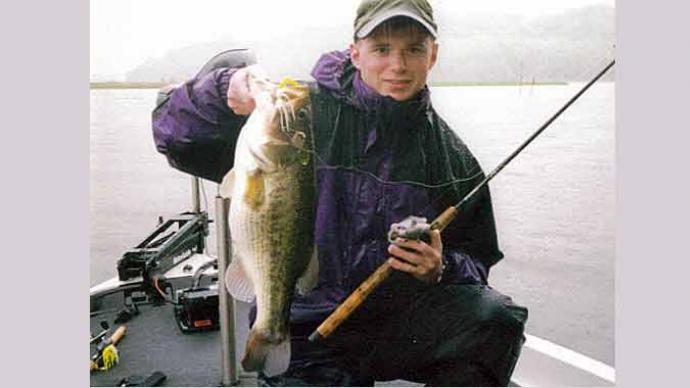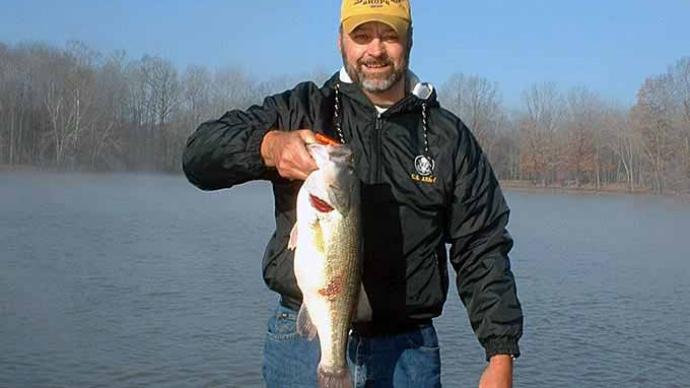
The bait of choice in most Texas reservoirs come January is the jig-and-pig, but down here in south Texas you'll find the spinnerbait to be king. Why is this? Well, the lakes water temperatures stay quite moderate down here all winter. Seldom does the surface temperature drop below 60 degrees. Of course there can be exceptions. Regardless, a spinnerbait can be an exceptional tool even in colder water when used properly.
The lakes I'm speaking of are Corpus Christi, Choke Canyon, Coleto Creek and Falcon. You'll note that I didn't include Amistad or Canyon lakes. Both of these clear-water, rocky lakes will have temperatures hovering in the low to mid- 50's from December through March. Bulky jigs will put a trophy bass in your boat if you're patient and persistent. Pork rinds of all kinds are used by hoards of winter anglers. These rinds really make jigs look delicious to bass that like to suspend in depths that offer a little warmer temperatures. The cold water really messes up their metabolism and makes them a bit slow and sluggish. However, thank goodness they will still maintain a darned good appetite. So you can see why a 1/2-ounce black jig with a jumbo Uncle Josh frog chunk on it can really turn them on. But they won't chase it. No indeed, you've got to hop it slowly, and even slower if you expect to score.
So why am I talking about jigs and such when this is an article about spinnerbaits and how to use them in winter? I do so simply because the jig and spinnerbait are so similar in design and techniques for fishing them. The only physical difference between the two is the spinner blade and the wire it's attached to.
A spinnerbait can be fished in the same hopping manner as you'd work a jig. Just remember S-L-O-W is the key word. You can dress a spinnerbait with a pork frog chunk the same as you would a jig. My favorite combination on Falcon come January is a 3/8- ounce black-skirted spinnerbait adorned with a 4-inch black Uncle Josh split-tailed spring lizard. I also prefer a #4 hammered nickel blade. And I love to recall why I consider this spinnerbait my all-time favorite. The date was February 5, 1986. My partner and I had the good fortune to win the Lone Star Team Tournament held here on good old Falcon. We won the two-day affair with a 20-fish limit that weighed 89.77 pounds. This established a new state team record. The old record was 76.30, taken on Lake Tawakoni. Our record can never be bested because the very next year Texas Parks and Wildlife lowered the daily limit to five fish. Incidentally, all 20 of the bass fell to the aforementioned favorite spinnerbait.
We found those fish in the very back end of Little Tigre Arroyo. The water temperature in there was 60 to 62 degrees whereas, the main lake temps were running 56 to-58 degrees. All the fish we caught came from two to four feet and they were loaded with eggs.
Slow-rolling was the only way they would take the bait. We limited (10 fish each) in less than two hours both days!
Isn't it amazing what a difference four degrees can make during winter's coldest periods? So why do you suppose this gosh-awful bunch of bass were stacked way up in this old creek? Think about it. This is a sandy-bottomed creek loaded with downed willows and mesquite brush, less than 20 yards wide. It runs east to west, catching the warm sun rays all day long and is completely protected from those chilly cold front winds. Could a mama bass want for more? Not in my opinion.
Keep these factors in mind when planning your next winter trip. Between January and March you can hook up with some big old sow bass in relatively shallow water if you just use your head.
The key words to remember are location, temperature and presentation.
While I don't claim to be a great jig fisherman, I do know how to work my spinnerbaits for the same kind of good catching during cold-water conditions.
About the only time I cast and retrieve my spinnerbait during the cold months is when the surface temperature is above 60 degrees. If water temps fall into the mid- to low 50's, you'll find me pitching it to the hardwoods and working it the same way I would a jig. I let it fall to the base of the hard wood while maintaining a light, constant contact with the lure as it bounces off the limbs on the way down. It's here when you must become a line watcher. Seldom will you get that hard tap that mostly occurs during late spring to fall. Most of my bass like to take the bait and move sideways or straight up and the use of braided line allows me the advantage of seeing the strike as opposed to trying to feel it. Mono is good, but it's hard to see especially during poor light conditions and the braided line can save you fish because of its strength.
I believe the blade on a spinnerbait helps draw the attention of a bass in heavy timber. Let me cite an example of what I'm trying to point out. During a November club tournament here on Falcon a couple of years back when the Coyotes had good water in the back, my buddy and I were fishing the main creek that was gushing clay-colored water from a heavy rain back in the Mexican hills. I'd positioned the boat just outside the fast-running water and was flipping my black spinner in bare mesquite hardwoods near the green willows that were being flooded by the run-off water. I saw my line jump or twitch on the drop and immediately set the hook. Luck and stout line rewarded me with a big old bass that weighed 9.01!
After sitting for about five minutes getting my lure and line cleared, I flipped into another hardwood not more than 10 yards from where I'd just caught the first fish. As I feathered my line down I noticed it move to my left about six inches from where I'd placed it next to the trunk of the mesquite. Setting the hook was only the start of my problems! This old gal shot to the bottom and wrapped my line over and under about three limbs.
I didn't hesitate going in after her. The water was less than five feet deep and still in the 70's. When my buddy placed her on the scale, she hit 9.11 pounds! Now tell me luck has nothing to do with success. In my 50 years plus of bass angling I never thought I could catch two nine-pounders back to back - much less in a tournament!
While we've pretty well covered the effectiveness of a spinnerbait being a solid choice for winter bassing, I feel compelled to discuss another important piece of tackle - your rod. My personal rod choice is IMX G-Loomis, length six-foot and medium-heavy action for fishing spinnerbaits in winter. I suppose my reason for discussing this is fairly simple - you should never try to whip a gorilla with a small twig, Bad things can happen! I don't care if you're using a seven-foot flipping stick or whatever - just make sure it's a top quality graphite product. If you expect to pull a four-pound or larger bass from heavy timer you should take advantage of any and all tackle to make the catch possible. This goes for rods, line and lures.
If conditions are normal come January, let me share with you how I will go about fishing for pre-spawn bass. Granted not all females will be in pre-spawn mode. Some will be ready to get on the nest and some will have spawned here, but on other lakes in the state they won't be started just yet. Keep in mind that the major spawn starts in the south about the first part of February, March and even as late as April in colder water. I like to fish Mexico's arroyos first at Falcon. The water tends to be warmer there. I'll fish the deeper ledges first, and this can apply to just about any lake you'll fish during colder months. Work any timber from four to eight feet with a spinnerbait just like I described earlier. Then simply continue moving towards the backs of the creeks until you've covered about one-third of it. Cross over to the other side and fish there.
Spinnerbait skirt colors will range this time of year from crawdad to black, blue/black and perch colors. I tend to experiment with blade colors quite often too. Orange painted blades sure make black and crawdad-colored skirts look very good. Green and blue blades have caught some nice bass for me as well. My hammered Colorado and Indiana blades are standard ammo this time of the year and one other blade that has helped me a lot in winter is a copper one. Get some when you can if you don't have them already!
Basically just don't hang up your spinnerbaits until spring has fully arrived. Fish them slowly and experiment with colors and styles. Bulk them up like you would a jig and don't be afraid to fish them exactly the same way.
It's my hope that this winter and early spring season will bring you lots of fun and excitement. Keep your bait wet all day and the odds will be in your favor! Stay dry and warm and above all don't mess with Mother Nature.




